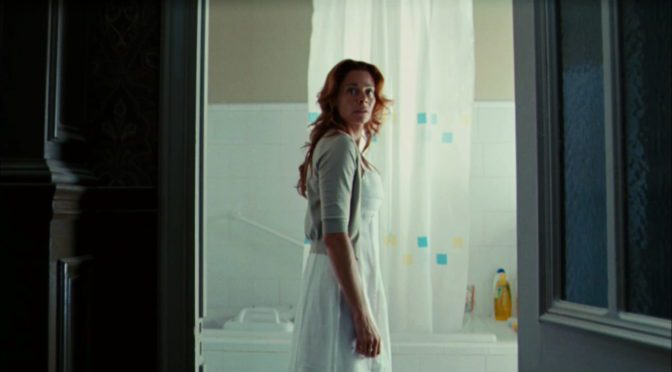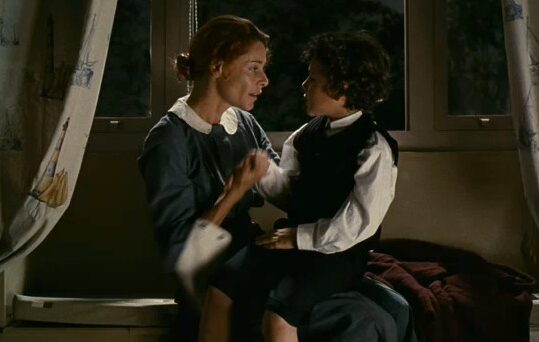“Que es un fantasma, Carlos?”
On paper, The Orphanage should be a rote, assembly-line horror film. It features creepy kids, a missing son, a spooky old woman, a giant house in the middle of nowhere, invisible friends, disfiguration, dolls, and a cloth-sack mask. If The Orphanage was made in the 1960s or ’70s, this would make sense, but this film came out in 2007. It shouldn’t feel this fresh. It shouldn’t be this good. What it shows us is that there’s a reason that the haunted house formula works – and this is what it looks like when it’s done right.
The Orphanage takes place at the Good Shepherd Orphanage, where Laura grows up before being adopted. Years later, she lives there as an adult (played by Belen Rueda), who lives there with her doctor husband Carlos (Fernando Cayo) and their adopted son Simon (Roger Princep. absolutely terrific). Simon doesn’t know that he’s adopted, and furthermore doesn’t know that he has HIV, for which he takes a pill every day. (In a great, telling shot, Laura and Carlos stop playing piano together to watch Simon take his medication.) Kids are not a new element in horror films, but it’s only in recent years that movies like The Babadook (which we’ll cover soon) and Insidious have started to examine the parents’ role in these stories, and The Orphanage seems like a logical starting place for that shift in attitude.
The Orphanage, like The Exorcist, uses a slow-burn approach to horror that starts from the first scene. There are no jump scares in this film, only a slowly increasing sense of dread, and, eventually, of panic. Director J.A. Barona (who will take the reins of the next Jurassic World film) and his cinematographer Oscar Faura (The Imitation Game) compose their shots in shades of blue, creating a dreamlike world of shadows and hues. Most interiors – say, a hospital room – seem finite and cramped, almost coffinlike, whereas Laura’s house obeys the rules of Gothic horror; its geometry and internal geography is never firmly established, turning it into a labyrinth where anything can happen and anyone can hide.
The Orphanage is scary, yes, but it is also deeply sad. When Simon disappears, the film focuses not on the bag-headed child Tomas that was the sole focus of its ad campaign, but rather on Laura and Carlos’s deep, existential despair. In a perfect scene, Laura lays in bed, delivering a heartfelt monologue to Carlos, laying beside her. “Simon made us stronger,” she laments, and then Carlos walks out of the bathroom, leaving Laura to wonder who was laying in bed next to her. It’s emblematic of The Orphanage on a macro scale, and shows the intimate relationship between grief and terror.
The supporting cast is top-notch. While characters like Carlos and a psychologist named Pilar (played by Mabel Rivera) don’t get a lot to do, everyone else is so damn good that it’s easy to excuse. Princep is amazing as Simon (after The Exoricst and Hocus Pocus, great child actors seem to be a recurring theme of 31 Days of Fright) – he’s loving and playful, but also mercurial and spiteful. He’s not the standard creepy kid that horror movies have trained viewers to expect; behind Princep’s dark eyes lies genuine complexity.
Geraldine Chaplin (daughter of Charlie) excels as Aurora, my favorite character in the film. She’s a medium who comes to the house to try to find Simon, which should be a red flag because that’s another worn-out trope of the haunted house genre (it happens in Insidious, which I like, but which is almost a beat-for-beat remake of this film). But it’s through Aurora, and Chaplin’s tough, maternal, physical performance, that we see some of the horror of the orphanage. She finds a room full of ghosts, ghosts that only she can see but which serve to terrify nonetheless. (The Orphanage, at times, does a lot with a little.)
But it’s the film’s ending that conjures feelings of shock, despair, and admiration at its sheer audacity. It’s here that The Orphanage shows itself as a haunted house movie where the house doesn’t need to be haunted. (Spoilers ahead.) When Laura finds a secret cellar, she discovers Simon’s body, a lifeless husk lying near a broken bannister (his shriveled legs make for a subtly gruesome image). He was there the whole time, the entire nine months Laura looked for him, and the heartbreak comes not only at the image and reality of a dead child, but at the realization of Laura’s greatest fear: that she’s a bad mom. The final image, of Laura dead from an overdose, reunited with her son and her friends from the orphanage, would be almost unbearably sweet if it weren’t for the feelings it evokes, not just happiness, but relief, and joy.
The Orphanage would have been a fine haunted house movie, if that’s all it wanted to be (“One, two, three, knock on the wall” will inspire dread in anyone who has seen the film). But it’s a much more intimate, personal story than you’d guess at a glance. It takes guts to end a horror film on a happy note; somehow, Bayona was able to kill his two main characters and leave the audience smiling.
10/1: Dawn of the Dead (2004)
10/2: The Exorcist
10/3: Pontypool
10/4: Hocus Pocus
10/5: The Orphanage
10/6: Rosemary’s Baby
10/7: Alien
10/8: Scream series
10/9: Scream series
10/10: Cujo
10/11: The Cabin in the Woods
10/12: Pulse
10/13: The Babadook
10/14: Friday the 13th
10/15: The Last House on the Left (both versions)
10/16: The Thing (both versions)
10/17: Little Shop of Horrors
10/18: Hush
10/19: Silent Hill
10/20: The Shining
10/21: Funny Games (2007)
10/22: Evil Dead series
10/23: Evil Dead series
10/24: The Mist
10/25: The Ninth Gate
10/26: The Fly
10/27: A Nightmare on Elm Street
10/28: The Nightmare Before Christmas
10/29: 28 Days Later/28 Weeks Later
10/30: It
10/31: Halloween (either version)







